3 aug 2017
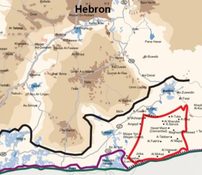
A 26-mile stretch of Wall, 20-feet high and made from cement, has been completed in the South Hebron Hills, in the southern part of the West Bank, according to Israeli sources.
This section of Wall divides the southern part of the West Bank and cements the illegally established settlements put in place by some of the most right-wing extremist groups in Israel.
According to Israeli sources, the section of the Wall that has been completed runs from the Turquimiya Crossing to the Israeli settlement of Mitar.
Palestinians from the village of Yatta, which is being divided by the Wall, were told by Israeli army officials that the Wall is being constructed through their village land as an act of collective punishment, since some young men from Yatta participated in a shooting attack against Israeli civilians in 2016.
Now, according to the local sources, the Israeli military has deemed the entire area a ‘closed military zone’ and is collectively punishing the residents by taking over huge swaths of land and dividing families, shutting off access to farmlands and effectively placing a chokehold on the residents of Yatta and other villages in the South Hebron Hills.
Issa Amro, a Palestinian youth from Hebron and the founder of Youth Against Settlements in Hebron, has organized efforts for years to stop construction of the Wall through non-violent action, telling the Electronic Intifada last year, “Nonviolence is the best tool because it strengthens civil society and it gives a role to each person: the kids, the women, the elders and the youth. With nonviolent activities you get more international support and you neutralize the violence of the oppressor”.
According to the Israeli group B’Tselem, “The policy of the Civil Administration is to prevent construction in nearly all Palestinian villages in the South Hebron Hills. One way this is done is by not preparing master plans that would enable the legalization of existing construction as well as future development.
“The Civil Administration maintains that the master plan in force is the one approved by the British mandatory authorities in 1942. Under that master plan, the area was zoned for agricultural use. However, although the plan does permit some construction on agricultural land, the Civil Administration has misinterpreted the plan’s instructions and has forbidden any and all construction.
“Without approved construction plans, Palestinians are denied any possibility of obtaining building permits, be it for housing or for public buildings such as schools and medical clinics. Nor can they get approval for paving proper roads. In addition, the Palestinians may not hook up to either the power grid or the water pipelines that Israel has laid in the area, even though Israel has connected the settlements to both – including the so-called outposts that were constructed without the proper permits.
Although the Civil Administration has prepared several master plans for Area C West Bank Palestinian villages, these plans were in fact aimed at obstructing the possibility of development for those villages. For example, in the early 1990s the Civil Administration prepared a plan for the village of a-Tuwani in the South Hebron Hills. In 2009 the plan was updated and the area it covered was expanded. Contrary to the stipulations in the Jordanian planning and construction law to which Israel is bound, the plan was prepared without a prior planning survey that presents the needs of the village.
The Civil Administration plan allocated only 52 dunams [5.2 hectares] to the village and allocated no land at all for future development. Moreover, the plan did not include the entire built-up area of the village so that, if implemented, some existing houses would be detrimentally affected. Meanwhile the Civil Administration plan allocated 385 dunams [38.5 hectares] to the nearby settlement of Ma’on irrespective of the similarly sized populations of the two communities.
Furthermore, the plan apparently discounts the fact that a-Tuwani, with its school and medical clinic, services all the surrounding villages.
“Over the past year, the Civil Administration has argued that it cannot approve construction plans in the South Hebron Hills, because they do not meet the planning criteria it has stipulated for the legalization of construction for Area C Palestinian villages. These criteria address the size of the built area; the age and density of construction; proximity to existing communities, nature preserves or archeological sites; and the feasibility of constructing public buildings and infrastructure.
These criteria are intended primarily to impede construction in Palestinian villages. They do not take into account the complex structure of land ownership, the history of Palestinian residence on the land (documented at least as far back as the nineteenth century) or the residents’ independent ability to construct public buildings to serve the neighboring Palestinian communities. These criteria do not apply to Israeli settlements in the West Bank for which there is a separate planning track.
The construction plans for the settlements in the area, for which the Civil Administration made the necessary changes to the British plans, granted the settlers substantial tracts of land for agricultural use and future development. Moreover, the Civil Administration has not enforced planning and construction legislation in the settlement outposts in the area: Northwest Susiya, Avigayil, Mitzpe Yair, Havat Ma’on, Nof Nesher, Asael and Sansana. These outposts were all established without building plans and without any land allocation. Some were even built on private Palestinian lands.”
All Israeli settlement construction, and the Annexation Wall itself, are considered by the United Nations to be serious breaches of international law, including the Fourth Geneva Convention, to which Israel is a signatory.
This section of Wall divides the southern part of the West Bank and cements the illegally established settlements put in place by some of the most right-wing extremist groups in Israel.
According to Israeli sources, the section of the Wall that has been completed runs from the Turquimiya Crossing to the Israeli settlement of Mitar.
Palestinians from the village of Yatta, which is being divided by the Wall, were told by Israeli army officials that the Wall is being constructed through their village land as an act of collective punishment, since some young men from Yatta participated in a shooting attack against Israeli civilians in 2016.
Now, according to the local sources, the Israeli military has deemed the entire area a ‘closed military zone’ and is collectively punishing the residents by taking over huge swaths of land and dividing families, shutting off access to farmlands and effectively placing a chokehold on the residents of Yatta and other villages in the South Hebron Hills.
Issa Amro, a Palestinian youth from Hebron and the founder of Youth Against Settlements in Hebron, has organized efforts for years to stop construction of the Wall through non-violent action, telling the Electronic Intifada last year, “Nonviolence is the best tool because it strengthens civil society and it gives a role to each person: the kids, the women, the elders and the youth. With nonviolent activities you get more international support and you neutralize the violence of the oppressor”.
According to the Israeli group B’Tselem, “The policy of the Civil Administration is to prevent construction in nearly all Palestinian villages in the South Hebron Hills. One way this is done is by not preparing master plans that would enable the legalization of existing construction as well as future development.
“The Civil Administration maintains that the master plan in force is the one approved by the British mandatory authorities in 1942. Under that master plan, the area was zoned for agricultural use. However, although the plan does permit some construction on agricultural land, the Civil Administration has misinterpreted the plan’s instructions and has forbidden any and all construction.
“Without approved construction plans, Palestinians are denied any possibility of obtaining building permits, be it for housing or for public buildings such as schools and medical clinics. Nor can they get approval for paving proper roads. In addition, the Palestinians may not hook up to either the power grid or the water pipelines that Israel has laid in the area, even though Israel has connected the settlements to both – including the so-called outposts that were constructed without the proper permits.
Although the Civil Administration has prepared several master plans for Area C West Bank Palestinian villages, these plans were in fact aimed at obstructing the possibility of development for those villages. For example, in the early 1990s the Civil Administration prepared a plan for the village of a-Tuwani in the South Hebron Hills. In 2009 the plan was updated and the area it covered was expanded. Contrary to the stipulations in the Jordanian planning and construction law to which Israel is bound, the plan was prepared without a prior planning survey that presents the needs of the village.
The Civil Administration plan allocated only 52 dunams [5.2 hectares] to the village and allocated no land at all for future development. Moreover, the plan did not include the entire built-up area of the village so that, if implemented, some existing houses would be detrimentally affected. Meanwhile the Civil Administration plan allocated 385 dunams [38.5 hectares] to the nearby settlement of Ma’on irrespective of the similarly sized populations of the two communities.
Furthermore, the plan apparently discounts the fact that a-Tuwani, with its school and medical clinic, services all the surrounding villages.
“Over the past year, the Civil Administration has argued that it cannot approve construction plans in the South Hebron Hills, because they do not meet the planning criteria it has stipulated for the legalization of construction for Area C Palestinian villages. These criteria address the size of the built area; the age and density of construction; proximity to existing communities, nature preserves or archeological sites; and the feasibility of constructing public buildings and infrastructure.
These criteria are intended primarily to impede construction in Palestinian villages. They do not take into account the complex structure of land ownership, the history of Palestinian residence on the land (documented at least as far back as the nineteenth century) or the residents’ independent ability to construct public buildings to serve the neighboring Palestinian communities. These criteria do not apply to Israeli settlements in the West Bank for which there is a separate planning track.
The construction plans for the settlements in the area, for which the Civil Administration made the necessary changes to the British plans, granted the settlers substantial tracts of land for agricultural use and future development. Moreover, the Civil Administration has not enforced planning and construction legislation in the settlement outposts in the area: Northwest Susiya, Avigayil, Mitzpe Yair, Havat Ma’on, Nof Nesher, Asael and Sansana. These outposts were all established without building plans and without any land allocation. Some were even built on private Palestinian lands.”
All Israeli settlement construction, and the Annexation Wall itself, are considered by the United Nations to be serious breaches of international law, including the Fourth Geneva Convention, to which Israel is a signatory.
2 aug 2017
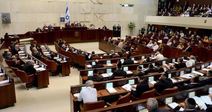
Members of Israeli Likud Party are scheduled to submit a new bill which supports the death penalty for Palestinian prisoners who are allegedly involved in anti-occupation attacks, Israeli media sources said.
According to the sources, the bill came under the garb of "anti-terrorism measures."
Deputy Knesset Chair MK Nava Boker (Likud) proposed a bill which would allow Israeli courts to sentence to death "those who acted as emissaries of our enemies and terror organizations, killing...the innocent."
"I have no doubt that the death penalty, together with other methods, will provide real deterrence and help us eradicate terror in Israel,” she claimed.
Earlier last month, Israeli Prime Minister Benjamin Netanyahu and Army Minister Avigdor Lieberman urged Israeli military courts to seek the death penalty for anti-occupation youths.
According to the sources, the bill came under the garb of "anti-terrorism measures."
Deputy Knesset Chair MK Nava Boker (Likud) proposed a bill which would allow Israeli courts to sentence to death "those who acted as emissaries of our enemies and terror organizations, killing...the innocent."
"I have no doubt that the death penalty, together with other methods, will provide real deterrence and help us eradicate terror in Israel,” she claimed.
Earlier last month, Israeli Prime Minister Benjamin Netanyahu and Army Minister Avigdor Lieberman urged Israeli military courts to seek the death penalty for anti-occupation youths.
1 aug 2017
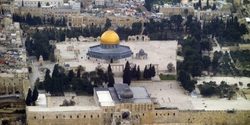
Israeli security forces have caused great damage to historical documents at Al-Aqsa Mosque during the two weeks of crisis over the Muslim holy site, officials say.
Head of the Manuscripts Department at Al-Aqsa, Radwan Amro, said in a statement that “the occupation authorities have caused huge and extensive destruction to the libraries and facilities at Al-Aqsa Mosque as well as the manuscripts section”, WAFA reported, according to PNN.
Amro further stated that specialized committees are continuing to assess and survey the damage, and will provide the official bodies with all the results once they are completed.
There has been great concern about Israeli theft of important documents from Al-Aqsa departments concerning property and Muslim endowment in Jerusalem, because of the lack of Waqf officials at the mosque.
Waqf officials are the ones in charge of the Al-Aqsa compound. They, alongside any Palestinians, have been prohibited to enter the compound for the past two weeks, due to the events that took place on July 14, where two police guards were shot dead.
However, Waqf media official, Firas Dibs, denied the rumors about theft of manuscripts and documents from the mosque.
Dibs said in a statement that Waqf technical committee has just started its survey of the mosque and it will take a while before it can presents its final conclusion.
Head of the Manuscripts Department at Al-Aqsa, Radwan Amro, said in a statement that “the occupation authorities have caused huge and extensive destruction to the libraries and facilities at Al-Aqsa Mosque as well as the manuscripts section”, WAFA reported, according to PNN.
Amro further stated that specialized committees are continuing to assess and survey the damage, and will provide the official bodies with all the results once they are completed.
There has been great concern about Israeli theft of important documents from Al-Aqsa departments concerning property and Muslim endowment in Jerusalem, because of the lack of Waqf officials at the mosque.
Waqf officials are the ones in charge of the Al-Aqsa compound. They, alongside any Palestinians, have been prohibited to enter the compound for the past two weeks, due to the events that took place on July 14, where two police guards were shot dead.
However, Waqf media official, Firas Dibs, denied the rumors about theft of manuscripts and documents from the mosque.
Dibs said in a statement that Waqf technical committee has just started its survey of the mosque and it will take a while before it can presents its final conclusion.
28 july 2017
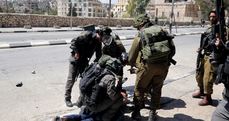
Palestinian Prisoners Center for Studies reported that Israeli occupation authorities (IOA) have escalated random arrest campaigns against Palestinians in the West Bank and Occupied Jerusalem since the Jerusalem anti-occupation attack in which two Israeli police officers were killed two weeks ago.
The Center recorded over 400 arrests among Palestinians including women, minors and political leaders as well as MPs, elderly people and others.
The spokesman of the Center, Riyad al-Ashqar, said that Israeli forces arrested 120 Palestinians at the plazas of al-Aqsa Mosque on Thursday alone. Among the detainees were 13 women including two girls aged 16 and 17 years old.
Ashqar pointed out that the Israeli arrests over the past couple of weeks also affected MP Omar Abdurrazeq, deputy on Salfit governorate, along with a number of Jerusalemite leaders including activist Amjad Abu Asab and the Fatah official in charge of the Jerusalem file Hatem Abdul Qader as well as Fatah Secretary in Occupied Jerusalem Adnan Ghaith.
The Center recorded over 400 arrests among Palestinians including women, minors and political leaders as well as MPs, elderly people and others.
The spokesman of the Center, Riyad al-Ashqar, said that Israeli forces arrested 120 Palestinians at the plazas of al-Aqsa Mosque on Thursday alone. Among the detainees were 13 women including two girls aged 16 and 17 years old.
Ashqar pointed out that the Israeli arrests over the past couple of weeks also affected MP Omar Abdurrazeq, deputy on Salfit governorate, along with a number of Jerusalemite leaders including activist Amjad Abu Asab and the Fatah official in charge of the Jerusalem file Hatem Abdul Qader as well as Fatah Secretary in Occupied Jerusalem Adnan Ghaith.
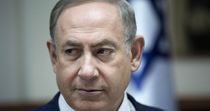
Israeli Prime Minister Benjamin Netanyahu on Thursday said he supports the death penalty for Palestinians who are involved in anti-occupation attacks.
“Time has come to impose death penalty,” Netanyahu said during his visit to the family of the three settlers who were killed last Friday in a stabbing attack.
“It’s anchored in the law. You need the judges to rule unanimously on it, but if you want to know the government’s position and my position as prime minister, in a case like this, of a base murderer like this, he should be executed.”
Last Friday, 19-year-old Omar al-Abed, from a nearby West Bank village, was shot and injured for allegedly being involved in a stabbing attack in the illegal settlement of Halamish. Three settlers were proclaimed dead during the incident.
Earlier Sunday, Israeli Army Minister Avigdor Lieberman, Justice Minister Ayelet Shaked, and Education Minister Naftali Bennett urged Israeli military courts to seek the death penalty for al-Abed after Intelligence Minister Yisrael Katz had initiated the demand on Saturday night.
Following the incident, Israeli forces notified al-Abed’s family with demolition of their house.
“Time has come to impose death penalty,” Netanyahu said during his visit to the family of the three settlers who were killed last Friday in a stabbing attack.
“It’s anchored in the law. You need the judges to rule unanimously on it, but if you want to know the government’s position and my position as prime minister, in a case like this, of a base murderer like this, he should be executed.”
Last Friday, 19-year-old Omar al-Abed, from a nearby West Bank village, was shot and injured for allegedly being involved in a stabbing attack in the illegal settlement of Halamish. Three settlers were proclaimed dead during the incident.
Earlier Sunday, Israeli Army Minister Avigdor Lieberman, Justice Minister Ayelet Shaked, and Education Minister Naftali Bennett urged Israeli military courts to seek the death penalty for al-Abed after Intelligence Minister Yisrael Katz had initiated the demand on Saturday night.
Following the incident, Israeli forces notified al-Abed’s family with demolition of their house.
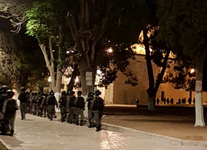
Dozens of Israeli soldiers invaded, shortly after midnight, the courtyards of the Al-Aqsa Mosque, in occupied East Jerusalem, and assaulted hundreds of worshipers, wounding dozens, in addition to shooting 15 worshipers, including two who suffered serious wounds, and six medics, with rubber-coated steel bullets in the head, and abducted 120 worshipers.
The invasion into the mosque started from al-Magharba Gate area, when the soldiers fired many firebombs, gas bombs, concussion grenades and rubber-coated steel bullets, to force the Palestinians out of the holy site.
The soldiers then surrounded al-Qibli mosque, in Al-Aqsa compound, abducted 120 Palestinians, including two guards of Al-Aqsa, identified as Khaled Sharawna and Luay al-Qawasmi, and moved them to several detention and interrogation facilities.
Medical sources said the Israeli attack led to dozens of injuries, including fifteen who were shot with rubber-coated steel bullets in their heads, and six medics.
The soldiers also prevented dozens of medics from entering Al-Aqsa Mosque, and attacked many of them, before closing it to all Palestinians.
The sources added that many Palestinians suffered serious injuries, two of them were rushed to al-Magharba Gate, and were moved to a hospital by an Israeli ambulance.
The Maan News Agency said the soldiers confiscated the mobile phones from all the abducted Palestinians, in addition to abducting another Palestinian, identified as Mohammad Khader Abu al-Hummus, near Damascus Gate.
The attack was the second in just a few hours, as the soldiers assaulted dozens of worshipers after evening prayers, Thursday, and fired dozens of gas bombs and concussion grenades, in addition to several live rounds, to remove the Palestinians out of the mosque, before shutting down all of its gates, and the Old City gates.
The Israeli army and police also prevented all Palestinians males, below the age of fifty, from entering Jerusalem’s Old City.
It is worth mentioning that various Palestinian figures, including national and religious leaders, are planning to hold an urgent meeting to discuss the renewed Israeli escalation, which comes hours after the army lifted the siege on the mosque, after the constant and persistent struggle to end the siege, which was violently reinstated ahead of Friday prayers.
The situation in Jerusalem remains very tense, especially as the army pushed dozens of additional units around Al-Aqsa, and the Old City, in addition to installing dozens of roadblocks and deploying mounted units, preventing the Palestinians from approaching the holy site.
The invasion into the mosque started from al-Magharba Gate area, when the soldiers fired many firebombs, gas bombs, concussion grenades and rubber-coated steel bullets, to force the Palestinians out of the holy site.
The soldiers then surrounded al-Qibli mosque, in Al-Aqsa compound, abducted 120 Palestinians, including two guards of Al-Aqsa, identified as Khaled Sharawna and Luay al-Qawasmi, and moved them to several detention and interrogation facilities.
Medical sources said the Israeli attack led to dozens of injuries, including fifteen who were shot with rubber-coated steel bullets in their heads, and six medics.
The soldiers also prevented dozens of medics from entering Al-Aqsa Mosque, and attacked many of them, before closing it to all Palestinians.
The sources added that many Palestinians suffered serious injuries, two of them were rushed to al-Magharba Gate, and were moved to a hospital by an Israeli ambulance.
The Maan News Agency said the soldiers confiscated the mobile phones from all the abducted Palestinians, in addition to abducting another Palestinian, identified as Mohammad Khader Abu al-Hummus, near Damascus Gate.
The attack was the second in just a few hours, as the soldiers assaulted dozens of worshipers after evening prayers, Thursday, and fired dozens of gas bombs and concussion grenades, in addition to several live rounds, to remove the Palestinians out of the mosque, before shutting down all of its gates, and the Old City gates.
The Israeli army and police also prevented all Palestinians males, below the age of fifty, from entering Jerusalem’s Old City.
It is worth mentioning that various Palestinian figures, including national and religious leaders, are planning to hold an urgent meeting to discuss the renewed Israeli escalation, which comes hours after the army lifted the siege on the mosque, after the constant and persistent struggle to end the siege, which was violently reinstated ahead of Friday prayers.
The situation in Jerusalem remains very tense, especially as the army pushed dozens of additional units around Al-Aqsa, and the Old City, in addition to installing dozens of roadblocks and deploying mounted units, preventing the Palestinians from approaching the holy site.
27 july 2017

Israeli soldiers injured, on Thursday evening at least 121 Palestinians in the courtyards of Al-Aqsa Mosque, and the Old City, in occupied East Jerusalem.
The soldiers assaulted the worshipers following evening prayers, held in Al-Aqsa Mosque, courtyards and near the gates of the old city, and fired dozens of concussion grenades and rubber-coated steel bullets.
The Maan News Agency said the soldiers prevented hundreds of Palestinians from entering Al-Aqsa Mosque, an issue that pushed them to pray outside the holy site, including near the mosque’s ancient gates, and in the surrounding streets.
Hundreds of young Palestinian men, who were denied access to the mosque, prayed outside the holy sites near its gates and in the streets.
It added that the soldiers closed many of the gates, including Bab Hotta, while hundreds of officers were also deployed in the courtyards of the mosque and the Old City.
The soldiers then announced that only elders and women would be allowed into the holy site, for what they called “security considerations,” before the army and police resorted to excessive force to remove the worshipers, and issue that led to clashes.
The Palestinian Red Crescent (PCR) said its medics provided treatment to 113 Palestinians, adding that among the wounded are persons who were assaulted by the soldiers, and suffered fractures and bruises, in addition to many who were shot with rubber-coated steel bullets, gas bombs and concussion grenades.
The PRC added that its medics moved fifteen wounded Palestinians to hospitals and medical centers in occupied Jerusalem.
It also stated that the soldiers prevented its ambulances from reaching the gates leading to the mosque, and issue that forced the medics to rush into the holy site on foot carrying their stretchers and first aid tools.
It is worth mentioning that, despite the Israeli restrictions and blockades, more than 30.000 Palestinians managed to enter Al-Aqsa courtyards and held evening prayers.
The soldiers assaulted the worshipers following evening prayers, held in Al-Aqsa Mosque, courtyards and near the gates of the old city, and fired dozens of concussion grenades and rubber-coated steel bullets.
The Maan News Agency said the soldiers prevented hundreds of Palestinians from entering Al-Aqsa Mosque, an issue that pushed them to pray outside the holy site, including near the mosque’s ancient gates, and in the surrounding streets.
Hundreds of young Palestinian men, who were denied access to the mosque, prayed outside the holy sites near its gates and in the streets.
It added that the soldiers closed many of the gates, including Bab Hotta, while hundreds of officers were also deployed in the courtyards of the mosque and the Old City.
The soldiers then announced that only elders and women would be allowed into the holy site, for what they called “security considerations,” before the army and police resorted to excessive force to remove the worshipers, and issue that led to clashes.
The Palestinian Red Crescent (PCR) said its medics provided treatment to 113 Palestinians, adding that among the wounded are persons who were assaulted by the soldiers, and suffered fractures and bruises, in addition to many who were shot with rubber-coated steel bullets, gas bombs and concussion grenades.
The PRC added that its medics moved fifteen wounded Palestinians to hospitals and medical centers in occupied Jerusalem.
It also stated that the soldiers prevented its ambulances from reaching the gates leading to the mosque, and issue that forced the medics to rush into the holy site on foot carrying their stretchers and first aid tools.
It is worth mentioning that, despite the Israeli restrictions and blockades, more than 30.000 Palestinians managed to enter Al-Aqsa courtyards and held evening prayers.
